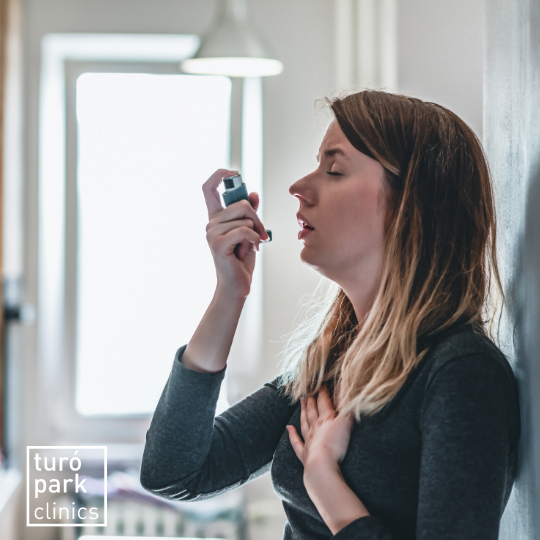Do you suffer from asthma and are looking for a doctor in Barcelona?
The prevalence of asthma in Europe is 5-7% in adults. This prevalence has doubled over the last twenty years, but is currently stabilising in most countries. Asthma is therefore a very common condition but can greatly diminish the quality of life of those who suffer from it.
The doctors at Turó Park Clinics offer their professional expertise to help asthma patients improve their condition, relieve their current symptoms and prevent exacerbations. It should be noted that the flu vaccine is strongly recommended for people with cardiovascular and respiratory risk factors, such as asthma, before the cold weather arrives.
If you suffer from asthma or any other respiratory problem, do not hesitate to make an appointment with one of our general practitioners for personalised care in terms of diagnosis, treatment and prevention.
Fast track your treatment
To book an appointment or speak with a member of our team, please get in touch using the options below.

What is asthma?
Asthma is a chronic lung condition that causes acute flare-ups of difficulty in breathing. It is characterised by choking due to the inflammation of the breathing tubes, resulting in difficulty of air passing into the lungs.
These flare-ups occur randomly or after exposure to a trigger. Identifying and avoiding these factors can help to keep your symptoms under control:
- Allergies (dust, animal fur, pollen)
- Tobacco (smoke)
- Pollution, hazardous substances and chemical agents
- Atopy
There are some factors that are important to be aware of, such as consanguinity, family history of asthma and/or allergies, medical history, and occupational history.
What are the different types of asthma?
If you have asthma, it is important to know what type it is so that you can manage it more effectively. Asthma classifications are based on severity and are determined by the patient's symptoms or the results of lung function tests, such as spirometry.
A patient's asthma classification is determined by their pre-treatment symptoms, which may also change over time, so a patient may change asthma category. However, all categories can experience severe asthma attacks.
Attacks can occur in all age groups and usually begin in childhood, although asthma in children under 4 years of age can be difficult to diagnose, as its symptoms are often different from those of asthma in older children or adults.
The different severities of asthma range from intermittent, mild persistent, moderate persistent, to severe persistent.
We can also talk about types of asthma:
- Allergic asthma
- Non-allergic asthma
- Seasonal asthma
- Occupational asthma
- Exercise-induced asthma
- Asthma that is difficult to control
- Severe or severe asthma
How is asthma diagnosed?
To diagnose asthma and assess its importance, the doctor first relies on a precise description of the symptoms (breathlessness, wheezing, coughing), the circumstances in which these manifestations appear, their length of time, and their frequency. The presence of allergy or asthma in the patient's family is an additional argument in favour of an asthma diagnosis.
To confirm the diagnosis and then follow up asthma, breathing tests are carried out:
- Spirometry
- Plethysmography
- A bronchial provocation test
Your health is our priority.
Our English-speaking general practitioners welcome you for the diagnosis and treatment of all your health problems.

What are the treatments for asthma?
Treatment for asthma attacks and disease-modifying therapy are complementary in the management of asthma and it is important to be familiar with them. Your doctor will work with you to decide on the right treatment to control your asthma.
Inhaled corticosteroids are essential in the background treatment of people with so-called "persistent asthma" (stages 2, 3 and 4). Taken daily, these drugs reduce inflammation in the bronchial tubes, helping to improve airflow.
Long-acting bronchodilators are also used in the background treatment of asthma. They work by relaxing the muscles around the bronchial tubes, making it easier for air to pass through. They are always combined with inhaled corticosteroids. They are most often given in inhaled form, to be taken morning and evening.
Some forms of very severe asthma are treated with a corticosteroid tablet taken for several months: the dosage is then adapted to each individual.
These treatments are reserved for adults with severe eosinophilic asthma that is resistant to other asthma therapies. They are administered subcutaneously.
Our English-speaking asthma specialists
